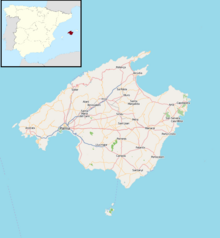Son San Joan Airport
|
Palma de Mallorca Airport Aeroport de Palma de Mallorca Aeropuerto de Palma de Mallorca |
|||||||||||||||
|---|---|---|---|---|---|---|---|---|---|---|---|---|---|---|---|
 |
|||||||||||||||
 |
|||||||||||||||
| Summary | |||||||||||||||
| Airport type | Public and military | ||||||||||||||
| Operator | ENAIRE | ||||||||||||||
| Serves | Mallorca, Spain | ||||||||||||||
| Location | Palma de Mallorca | ||||||||||||||
| Focus city for | |||||||||||||||
| Elevation AMSL | 7 m / 24 ft | ||||||||||||||
| Coordinates | 39°33′06″N 002°44′20″E / 39.55167°N 2.73889°ECoordinates: 39°33′06″N 002°44′20″E / 39.55167°N 2.73889°E | ||||||||||||||
| Website | aena-aeropuertos.es | ||||||||||||||
| Map | |||||||||||||||
| Location in Majorca | |||||||||||||||
| Runways | |||||||||||||||
|
|||||||||||||||
| Statistics (2016) | |||||||||||||||
|
|||||||||||||||
|
Sources: Passenger Traffic, AENA
Spanish AIP, AENA |
|||||||||||||||
| Passengers | 26,253,882 |
|---|---|
| Passenger change 15–16 |
|
| Aircraft movements | 197,639 |
| Movements change 15–16 |
|
Palma de Mallorca Airport (Catalan: Aeroport de Palma de Mallorca, Spanish: Aeropuerto de Palma de Mallorca; IATA: PMI, ICAO: LEPA) is an international airport located 8 km (5.0 mi) east of Palma, Majorca, Spain, adjacent to the village of Can Pastilla. Also known as Son Sant Joan Airport or Aeroport de Son Sant Joan, it is the third largest airport in Spain, after Madrid–Barajas and Barcelona. During the summer months it is one of the busiest airports in Europe, and was used by 26.2 million passengers in 2016. The airport is the main base for the Spanish carrier Air Europa and also a focus airport for Ryanair, EasyJet and Vueling.
The history of Palma de Mallorca airport began in the 1920s, when seaplanes were used for postal services to the other Balearic Islands. A flat field next to Son Sant Joan was then used in the 1930s for flight routes to other parts of Spain. A private aerodrome was also set up.
In 1938, Palma de Mallorca airport started being used for military aviation, while Iberia and Deutsche Lufthansa established new routes to the military base.
In 1954, Palma de Mallorca's runway was extended and asphalted, and also had brand new taxiways and aprons added near it. This made the airport able to serve more airlines and more types of aircraft.
...
Wikipedia

